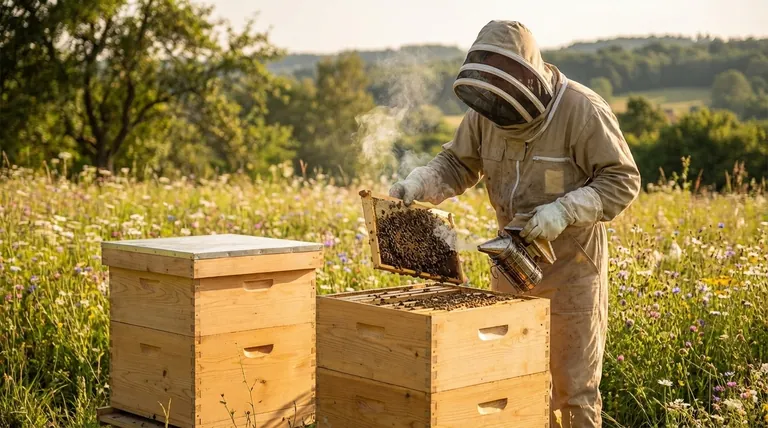Technically, yes, you can start beekeeping with a single hive. Many people do. However, this approach introduces significant risks that are easily avoided, which is why the overwhelming consensus among experienced beekeepers is to start with at least two.
While starting with one hive is possible, it is a high-risk strategy that removes your most powerful tool for solving problems: a second, healthy colony. Starting with two hives from the outset is the single best investment you can make to ensure a successful first year.

The Problem with a Single Hive
Putting all your resources and effort into one colony is akin to navigating without a map or a compass. You can do it, but you have no reference point if you get lost.
No Safety Net for Colony Loss
Colony failure is a common part of beekeeping, especially for beginners. A new colony might fail to establish, lose its queen, or succumb to pests or disease.
If your single hive fails, your beekeeping season is over. You are left with empty equipment and must wait until the next year to start again.
The Challenge of Diagnosis
As a new beekeeper, it's difficult to know what "normal" looks like. Is your hive quiet because the bees are content, or is it quiet because the population is dwindling?
Without a second hive for comparison, you lack a control group. A healthy colony next to a struggling one makes problems obvious and provides a clear benchmark for success.
Why Two Hives Are the Gold Standard
Starting with two hives is not about getting more honey; it's about risk management and accelerated learning. It provides you with options that are unavailable with a single colony.
The Power of Resource Sharing
This is the most critical advantage. A strong hive can be used to directly support a weaker one. You can solve many common and fatal hive issues by simply moving a frame from one box to another.
You can give a frame of eggs and brood to a queenless hive, allowing them to raise a new queen. You can provide a frame of honey and pollen to a hive with low food stores. You can even boost the population of a weak hive with a frame of capped brood from a strong one.
A Built-in Lesson in Colony Dynamics
No two beehives are ever the same. One may be gentle and productive, while the other is defensive and slow to build up.
Observing these differences side-by-side is an invaluable learning experience. It teaches you to appreciate the variability in bee genetics and behavior, making you a more adaptable and knowledgeable beekeeper.
Understanding the Trade-offs
The recommendation for two hives is based purely on increasing your odds of success, but it's important to acknowledge the practical considerations.
The Upfront Investment
Unquestionably, starting with two hives costs more. You are doubling your initial expense on woodenware, bees, and protective gear. However, many beekeepers consider this an insurance policy against the total loss of the smaller investment in one hive.
The Workload
Managing two hives is more work than managing one. That said, the inspections are typically done at the same time, and the increase in labor is not perfectly doubled. Most importantly, the work on a second hive provides twice the opportunity for hands-on learning.
If You Absolutely Must Start With One
If budget or space constraints make a second hive impossible, you are not destined to fail. However, you must proactively create your own safety net.
Your first action should be to find a local beekeeping mentor or join a club. A nearby beekeeper with established hives may be willing to provide a frame of brood or eggs in an emergency, giving you the same lifeline that a second hive of your own would provide.
Making the Right Choice for Your First Season
Your decision should be based on your personal goals and tolerance for risk.
- If your primary focus is maximizing your chance of success: Start with two hives to provide a crucial safety net and essential resource-sharing capabilities.
- If your primary focus is minimizing initial investment: You can start with one hive, but you must immediately connect with a local beekeeping mentor or club to serve as your support system.
Ultimately, setting yourself up with the right resources from day one is the surest path to a rewarding beekeeping journey.
Summary Table:
| Approach | Key Advantage | Main Risk |
|---|---|---|
| One Hive | Lower initial cost | Total loss of colony ends the season |
| Two Hives | Resource sharing & accelerated learning | Higher upfront investment |
Ready to start your beekeeping journey with the right equipment?
HONESTBEE supplies commercial apiaries and beekeeping equipment distributors with high-quality, durable beekeeping supplies through our wholesale-focused operations. Whether you're starting with one hive or ten, having reliable equipment is fundamental to your success.
Contact our expert team today to discuss your beekeeping supply needs and ensure your operation is built on a strong foundation.
Visual Guide

Related Products
- Langstroth Bee Hives Bee Keeping Box for Beginners Beekeeping
- Australian Langstroth Beehive Boxes for Beekeeping Wholesales
- Langstroth Honey Bee Box Hive Boxes for Different Depths
- HONESTBEE Professional Long Handled Hive Tool with Precision Cutting Blade
- Professional Insulated Plastic Bee Hives
People Also Ask
- What are the different types of beehive boxes available? Choose the Right Hive for Your Apiary
- Why are Langstroth hives recommended for beginners? Unmatched Support & Standardization
- Should a beginner try a different type of hive? Start with a Langstroth for a solid foundation.
- Why might a beginner be advised to start with a Langstroth hive? Unlock a Supportive Beekeeping Ecosystem
- Why were wooden hives traditionally preferred? For Natural Beekeeping Aligned with Bee Biology



















